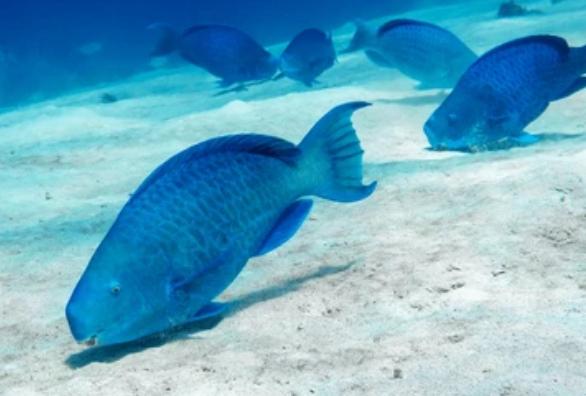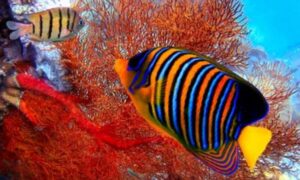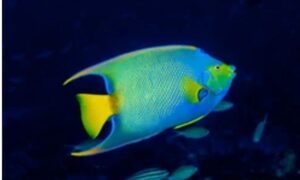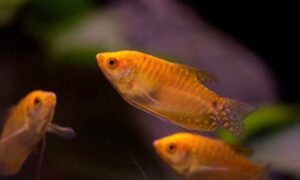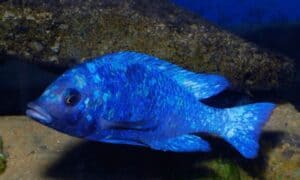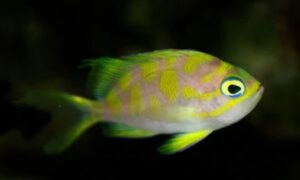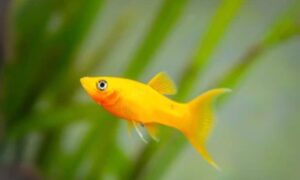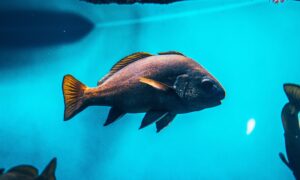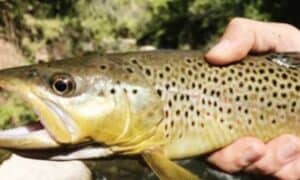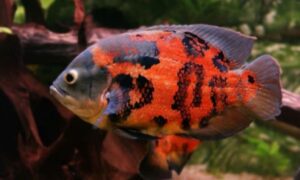The blue parrotfish is a captivating species of fish known for its vibrant blue coloration and unique characteristics. Its scientific name is Scarus coeruleus. It’s Native to Central and South America. This fascinating fish is very popular among fish lovers due to its bright blue coloration and unique features. With its unique body shape, and striking blue hues, the blue parrotfish stands out as one of the most enchanting and beautiful creatures of the ocean. There are a variety of blue parrotfishes that are available in pet trades.
Different types of parrot fish
Blue parrotfish is a popular marine creature that comes in different species. One commonly seen species is called the Midas Cichlid also known as Amphilophus citrinellus. These fish can grow up to 12 inches long and have a beautiful golden-yellow body. They have beautiful black markings on their head and fins. Some other types of parrotfish that fish lovers like are the Red Parrot Cichlid also known as Hoplarchus psittacus. It has a deep red body with yellow stripes. The Blue Parrot Cichlid also known as Cyrtocara moorii has a bright blue body with white spots, and the Electric Blue Hap (Sciaenochromis fryeri) has a stunning electric blue body with white stripes.
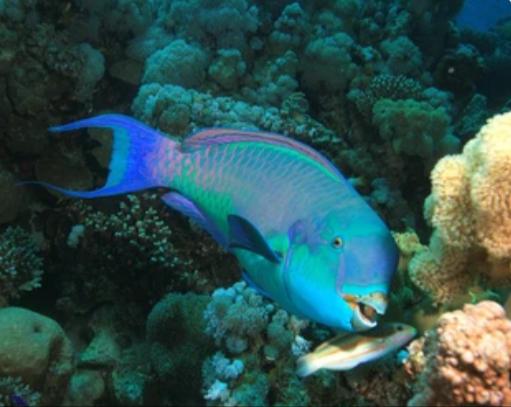
The lifespan of blue parrot fish
The blue parrotfish has a lifespan that can vary depending on many factors. On average, these fish can live for approximately 8 to 10 years. However, the point to be noted is that various environmental conditions and predation risks can influence their longevity. Factors like habitat quality, availability of good food, and protection from predators play important roles in determining the lifespan of blue parrotfish. By taking care of these factors, we can contribute to the well-being of this beautiful fish.
Diet of blue parrot fish
Blue parrot fish are omnivorous so they can eat both plant matter and tiny invertebrates. They have a varied diet which includes both plants and small creatures like brine shrimp, bloodworms, and tubifex worms. It’s best to feed them twice a day in small amounts, as giving them too much food can cause health issues like bloating or swim bladder disease.
To make sure your blue parrotfish stays healthy, it’s important to keep an eye out for signs of illness or stress. Watch for rapid breathing, sluggish behavior, loss of appetite, or cloudy eyes, as these signs mean that they have any infection or other health problems that need attention.
To create a suitable environment for your blue parrot fish, regular water changes are necessary. Changing a portion of the water each week helps maintain a clean and balanced tank. Also, make sure to clean the tank to keep your fish healthy and happy. Remove any leftover food from their tank to keep their tank clean. This will remove harmful waste and keep the aquarium ecosystem in good condition, promoting the well-being of your blue parrotfish.
Care requirements of Blue Parrotfish
These are some care requirements for blue parrotfish which you need to take care of if you are keeping them as your pets.
Tank size: Provide a spacious aquarium with a minimum size of at least 30 gallons for a single blue parrotfish. It’s better to keep larger tanks for multiple fish.
Water parameters: It’s important to maintain clean water conditions with a temperature between 75-82°F (24-28°C). The pH level should be around 7.5-8.5. Also, make sure to regularly test the water quality.
Filtration: You must Install a reliable filtration system to keep the water clean and properly oxygenated. It’s very important to have clean water to keep your Blue parrotfish healthy and happy.
Diet: You must provide them with a balanced diet that consists of high-quality fish flakes or pellets, supplemented with fresh vegetables like lettuce or blanched spinach. You can occasionally treat them with frozen or live foods, such as brine shrimp or bloodworms.
Feeding frequency: You must feed blue parrotfish in small portions twice a day. Make sure to avoid overfeeding to prevent any health issues.
Tank decorations: For tank decor, you can add plenty of hiding spots and caves using rocks, driftwood, or artificial structures. Blue parrotfish like to have places to retreat and establish their territories.
Tank mates: Be very careful while choosing tank mates for blue parrot fish. You must choose peaceful fish species that are similar in size and temperament. Avoid aggressive or fin nippers that can bully your blue parrotfish.
Regular maintenance: Perform regular water changes of around 20% every 1-2 weeks to maintain good water quality and remove accumulated waste. This will keep your fish healthy and happy.
Observations: This is very important. You must regularly observe the blue parrotfish for any signs of illness, stress, or abnormal behavior. If you find any symptoms of illness you must contact a vet as soon as possible.
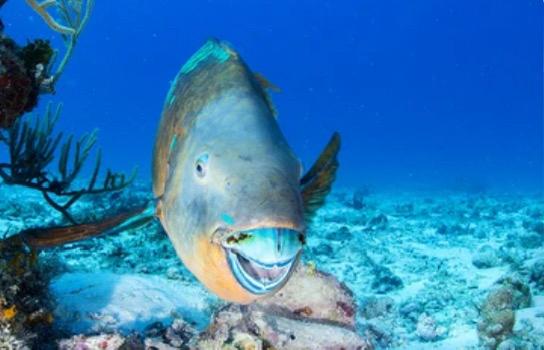
Blue parrot fish tank mates
When you are choosing tank mates for blue parrotfish, it is very important to consider their compatibility and the tank environment. They can coexist well with other peaceful and similar-sized fish species. Some suitable tank mates for blue parrotfish are Corydoras, Rosy barb, Gourami, Angelfish, Black Skirt Tetra, Severum Cichlid, Oscars, and Cory catfish.
Always avoid aggressive or fin-nipping fish that may bully or give stress to your blue parrotfish. Also, be careful of the tank size and provide enough hiding spots or territories to reduce fights among the fish.
FAQs
Are blue parrot fish rare
Blue parrotfish are not at all rare. They can be found in the warm coastal waters of the Western Atlantic Ocean, especially in the Caribbean Sea. While they may not be as commonly seen as some other fish species, still they are not considered rare or endangered. However, their population can be influenced by factors such as habitat degradation, overfishing, and environmental changes.
How big does a blue parrotfish get?
On average, they can reach a size of around 11 to 29 inches or 30 to 75 centimeters in length. But remember that the size of each blue parrotfish can vary depending on factors like their age, maturity, diet, and the environment they are living in.
Are blue parrotfish aggressive?
They are typically peaceful but Blue parrotfish can exhibit aggressive behavior towards other fish when it comes to defending their territory. As they grow larger, they may become more territorial and they will protect their territory at any cost.
Male parrotfish can also get aggressive during mating season as they compete for the attention of females. This aggression can involve chasing, biting, or engaging in territorial fights with other fish species. However, the point to be noted is that aggression levels can vary among individual parrotfish and are influenced by factors such as habitat conditions and availability of resources.
Conclusion
Blue parrotfish are captivating and beautiful fish with their vibrant colors and unique characteristics. They have a diverse diet including both plants and small invertebrates. Proper feeding habits, such as providing small portions and avoiding overfeeding, are very important to prevent health issues like bloating or swim bladder disease.
Monitoring the health of blue parrotfish is also very important to detect any signs of illness or stress, such as rapid breathing, lethargy, loss of appetite, or cloudy eyes.
Another important factor is to maintain a suitable tank environment for blue parrotfish, which involves regular water changes and a clean tank. These changes help keep the water clean, balanced, and free from harmful waste products.
Blue parrotfish can be good pets if they are in the right conditions. It’s important to note that they have specific care requirements. They need a spacious tank with proper filtration and enough room so they can swim comfortably. Also, they need their territory so it’s necessary to have a spacious tank for them. Blue parrotfish are better suited for experienced aquarium owners who can provide the necessary care and environment for these beautiful fish.
Blue parrotfish can be fascinating additions to a well-maintained aquarium, but they require attention to their diet, health, and tank conditions. With proper care and monitoring, blue parrotfish can thrive longer and bring joy to fish lovers.

